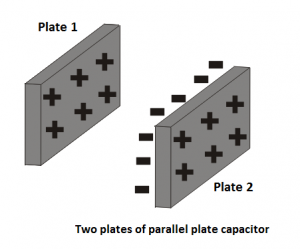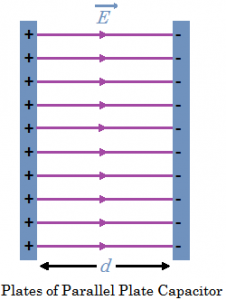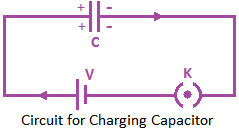Parallel Plate Capacitor
Parallel Plate Capacitors are the type of capacitors which are formed by arrangement of electrodes and insulating material (dielectric). The two conducting plates act as electrodes which are separated by a dielectric between them.
The two plates of parallel plate capacitor are of equal dimensions and is connected to power supply. The plate which is connected to positive terminal of battery acquires positive charge while the plate which is connected to negative terminal of battery acquires negative charge. Due to the attraction charges store between the plates.

Why Parallel Plate Capacitor is used?
Sometimes the electric charge to be stored in a capacitor is of high amount which can’t store in a single capacitor. So, parallel plate capacitor are used which used two plates as electrodes which help to store more electric charge.
Principle of Parallel Plate Capacitor: As we know that certain amount of charge can be given to a plate as if more charge is applied its potential will increase and charge might leak.
If we get another plate and place it next to this positively charged plate then negative charge will be pulled towards the side of this plate which is closer to the positively charged plate and positive charge on the further side.

As both the plates have charges the negative charge on plate 2 will reduce the potential difference on plate 1 while the positive charge on plate 2 will increase the potential difference on plate 1. But the negative charge on plate 2 will have more impact.so more charge can be given on plate 1 because of negative charges on plate 2 the potential difference will be less.

This is the principle of parallel plate capacitor. Charging of Parallel Plate Capacitor,

Let C be the two plates of capacitor, V be the potential difference and k be the switch in figure. Now when the key is closed then the electrons from the first plate start moving towards the positive end of the battery that is, there is flow of electrons from negative end to positive end of the battery.
The electrons which moved towards to the positive end of battery from there they will start moving towards to the second plate. In this way both the plates will acquire charges, one will acquire positive charge while other will acquire negative charge.
This process will continue until the capacitor acquires potential difference V in the exact same amount that of the battery. Now the process will stop. At this time when the process has been stopped the capacitor has stored electric charge on it with the potential difference which is same as battery.
So now the charge can be written as Q = CV.
